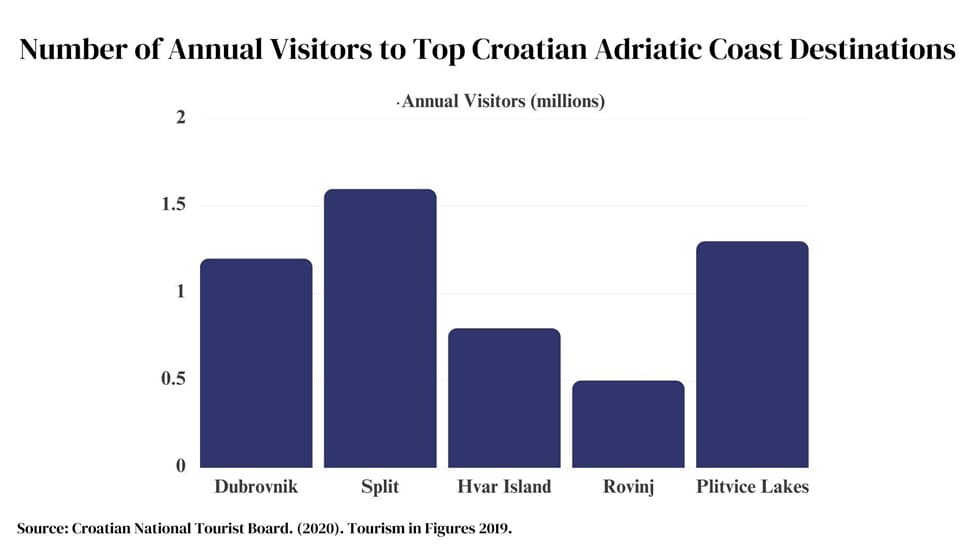Croatia’s sparkling Adriatic coast has turquoise waters, ancient cities, and lush forests. As you plan your dream trip, keep these tips in mind to craft an memorable experience along the shore.

Explore Famous Port Cities
Several historic ports dot the coastline. Walking their cobblestone streets is like going back in time.
Dubrovnik
The “Pearl of the Adriatic” is a must-see with its huge medieval walls and towers over red-roofed buildings. Take a cable car up Mount Srđ for amazing views of Dubrovnik and nearby islands.
Split
Split has Roman Emperor Diocletian’s Palace, now the lively town center. The sea organ along the harbor creates music from the waves.
Korčula
Heavily forested Korčula has quiet beaches and alleys with statues of locals like Marco Polo. Visit wineries on this island known for its white wine.
Rovinj
Winding cobblestone streets in Rovinj lead to pastel-colored houses and small squares. The hilltop church provides beautiful sunsets over the crowded harbor.
Marvel at Plitvice Lakes National Park
Plitvice Lakes National Park, a UNESCO site, has 16 terraced lakes formed by natural travertine dams. With green mountains behind, the lakes dazzle in shades of blue and green.
Relax on the Island of Hvar
Spend lazy days on Hvar soaking up the sunshine on picturesque beaches tucked into coves. Trendy beach bars have cocktails and fresh seafood. In the evening, check out shops and restaurants in Hvar Town.
Wander Through Diocletian’s Palace in Split
In Split, you’ll find the 4th-century Diocletian’s Palace, now a lively town center. Follow narrow streets to see ancient courtyards, temples, and artifacts. Stop for coffee at a café in the original palace walls. No Croatia trip is complete without visiting this historic palace complex.
Go Sea Kayaking Around Dubrovnik
Paddle along Dubrovnik’s ancient walls on a guided kayak tour. This offshore view reveals new angles on the imposing fortifications and rooftops. Kayaking lets you explore coves and relax on secluded pebble beaches. Learn about Dubrovnik’s maritime history.
Sample Local Wine on Korčula Island
Beyond beaches, Korčula makes white wine from the Grk grape. Visit family-run wineries for tastings. Buy a bottle at the weekly market and enjoy the views from the old tower.
Get Lost in the Alleys of Trogir
On a small islet, Trogir has winding cobblestone paths lined with 15th-century buildings. See the Romanesque-Gothic cathedral and Ćipiko Palace. Pop into craft shops and traditional tavernas.
Marvel at the Natural Pools of Krka National Park
South of Zadar, Krka National Park protects the pristine Krka River. Take a boat to Skradinski Buk, a huge travertine waterfall that’s an azure-green natural pool. Explore medieval island ruins.
Sample Oysters and Mussels from Mali Ston Bay
Mali Ston Bay has farmed oysters and mussels since Roman times. Take a boat trip and try the seafood paired with local wines. Paddle board or swim in the peaceful waters.
Immerse Yourself in Nature at Paklenica National Park
Paklenica Park near Zadar is great for rock climbing and hiking. Meander canyon walks or high-altitude treks with sweeping Adriatic views. Refuel on traditional Dalmatian cuisine at local restaurants.
Experience Hvar’s Lively Fisherman’s Night
Every evening as the sun sets over Hvar Town, fishermen return with the catch. Restaurants display the fresh seafood. Stalls sell lavender, olive oils, and crafts. Listen to folk music during this iconic island event.
Marvel at Mostar’s Famous Bridge
Nearby Mostar has a 16th-century stone bridge destroyed then rebuilt over the emerald Neretva River. Wander the lively Turkish bazaars and cozy cafés near historic mosques and churches.
Relax in Rovinj, a Jewel of the Adriatic
Rovinj on the Istrian Peninsula, with cobblestoned streets and pastel buildings, makes an idyllic base for exploring Istria’s wineries, beaches, and islands. Spend mornings at cafés in historic Grisia Street. Watch sunsets from Rovinj’s hilltop Church of St. Euphemia.
Experience Motovun Like a Local
On a hill in northern Istria, Motovun has panoramas over truffle-filled forests and vineyards. Meander the charming streets and sample delicacies like truffle dishes, pršut (prosciutto), and chocolates with truffle. Chat with artists at galleries tucked into ancient buildings. Enjoy sunset views from the city walls with local red wine.
Discover the Rich History of Pula
Dating back 3,000 years, Pula on the Istrian Peninsula has many Roman relics that provide insights into ancient history. Highlights include the well-preserved 1st-century amphitheater and elaborate floor mosaics. Don’t miss the seafood restaurants and beaches along the lively harborfront.
Start Planning Your Dream Adriatic Trip
With its blend of medieval cities, idyllic islands, and stunning parks, Croatia’s coast promises an unforgettable vacation. Use these tips to start crafting your own Adriatic dream itinerary. The sparkling waters await!
Frequently Asked Questions
When is the best time to visit Croatia’s Adriatic Coast?
The best time to go to Croatia’s Adriatic Coast depends on what you prefer. The busiest time with warm and sunny weather is from July to August, but it’s crowded and more expensive. For fewer crowds and lower prices, consider visiting in May/June or September/October.
What is the easiest way to travel between destinations along the Adriatic Coast?
If you want the most flexibility, renting a car is a good option. You can also use public ferries to hop between islands and coastal cities, while buses are great for traveling between towns and national parks further inland.
What should I pack for an Adriatic Coast trip?
Pack light, breathable clothes, a sun hat, comfy sandals, and swimwear for the beautiful beaches. Don’t forget sunscreen, a reusable water bottle, hiking shoes if you plan to explore, and a light jacket for cooler evenings.
How much does the average meal cost in Croatia?
You can expect to spend around $15-20 per person for a main dish at a regular local restaurant. Prices might be higher in very touristy places like Dubrovnik. If you want more affordable options, try eating at a konoba, which serves traditional dishes at lower prices.
Conclusion
With its irresistible blend of medieval cities, idyllic islands, and stunning national parks, Croatia’s Adriatic Coast delivers a multi-faceted vacation. Let this guide inspire you to start crafting your own Adriatic dream itinerary. The crystalline blue waters await!

